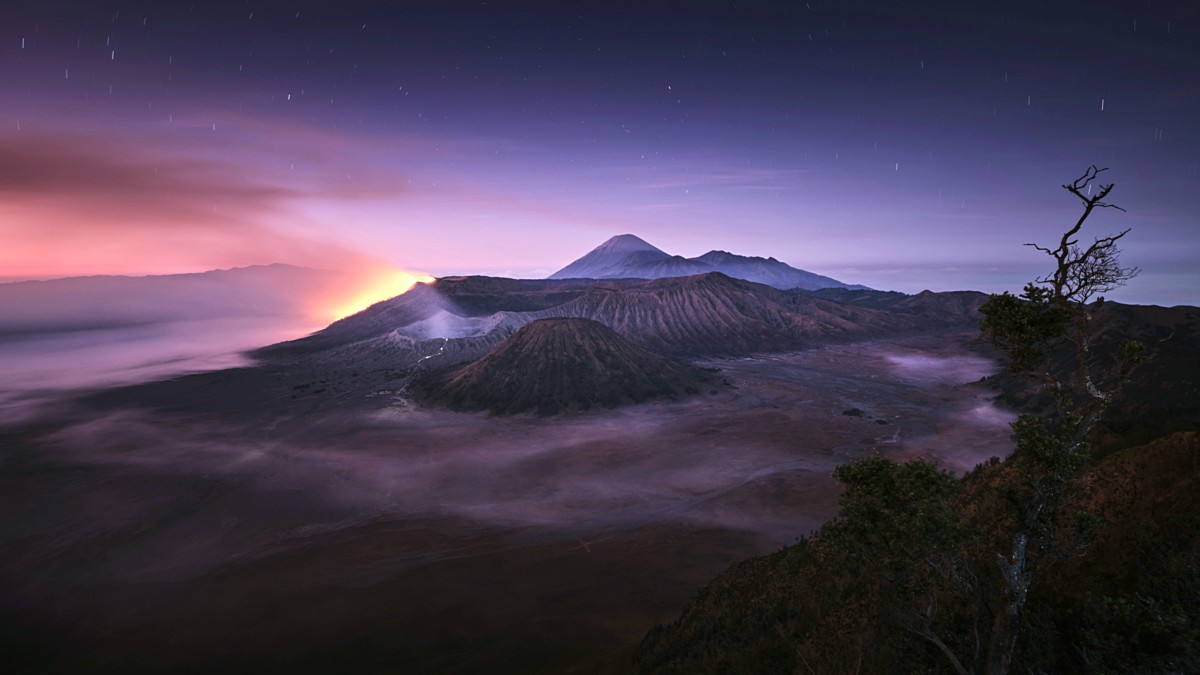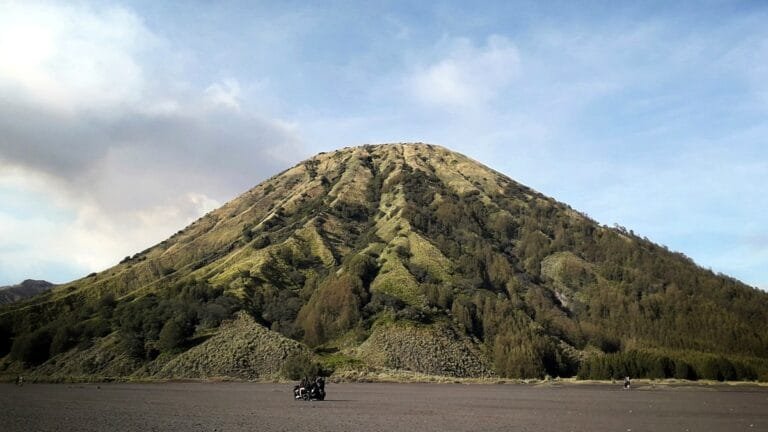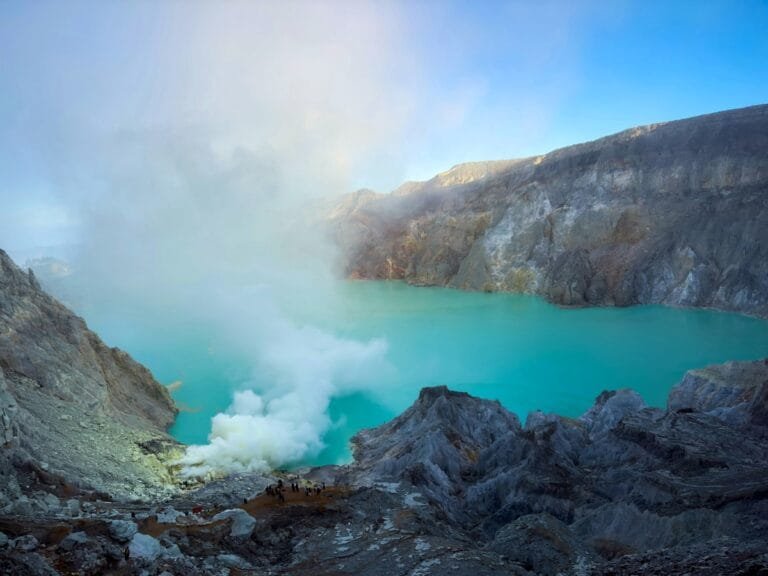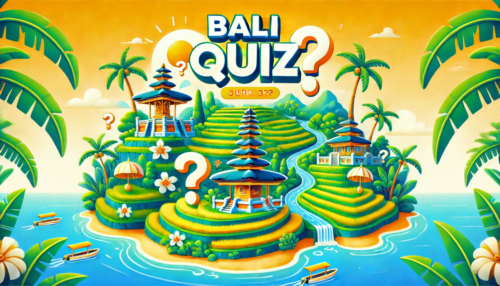Java’s landscapes blend volcanic peaks, ancient temples, and bustling cities—an island where history meets modernity.
Java: Indonesia’s Cultural Heartland of Temples, Volcanoes, and Urban Life
Java, Indonesia’s most populous island and the political, cultural, and economic hub of the country, is a land of contrasts. Stretching from west to east, Java is home to vibrant cities, ancient temples, active volcanoes, and lush landscapes. Whether you are exploring the streets of Jakarta, hiking to the summit of Mount Bromo at sunrise, or visiting the ancient temples of Borobudur and Prambanan, Java offers an experience that is as diverse as it is captivating.
Java’s central position in Indonesia’s history and development has made it a melting pot of cultures, religions, and traditions. This diversity is reflected in its architecture, cuisine, and daily life, offering visitors a dynamic blend of the old and new.
The Volcanoes of Java: An Adventurer’s Paradise
Java is part of the Pacific Ring of Fire and is dotted with active volcanoes, offering some of the most breathtaking and challenging hikes in Indonesia. One of the most iconic volcanoes on the island is Mount Bromo, located in East Java. Bromo is part of the Tengger Semeru National Park and is famous for its otherworldly landscapes, with a smoking crater surrounded by the vast Sea of Sand, an arid plain that looks like something out of a science fiction movie. The best time to visit Mount Bromo is at sunrise, when the sun casts a golden glow over the volcano and the surrounding peaks.
For a more challenging trek, Mount Semeru, Java’s highest volcano at 3,676 meters, offers a multi-day hike that attracts experienced adventurers. The climb to the summit is steep and arduous, but the panoramic views from the top are worth the effort. Another popular destination is Mount Ijen, known for its striking turquoise crater lake and the phenomenon of “blue fire,” caused by ignited sulfuric gases at night. Ijen is also famous for its sulfur miners, who manually extract sulfur from the crater and carry it down the mountain.
TIP: The best time to hike Java’s volcanoes is during the dry season, from May to September, when the weather is clear, and the trails are safer. Be sure to bring warm clothing, as temperatures at the summits can be quite chilly.
Ancient Temples: Borobudur and Prambanan
Java is home to some of the most magnificent ancient temples in Southeast Asia, and a visit to these historical sites is a must for anyone traveling to the island. The most famous of these is Borobudur, the largest Buddhist temple in the world. Located in Central Java, near Yogyakarta, Borobudur is an architectural masterpiece, built in the 9th century and designed as a massive mandala. The temple consists of nine stacked platforms topped by a central dome, surrounded by 72 stupas, each housing a Buddha statue. The temple’s walls are adorned with over 2,500 intricate relief panels depicting scenes from Buddhist texts, making Borobudur not only a religious site but also a historical and cultural treasure.
Just a short drive from Borobudur is Prambanan, a stunning Hindu temple complex dedicated to the Trimurti: Brahma the Creator, Vishnu the Preserver, and Shiva the Destroyer. Like Borobudur, Prambanan was built in the 9th century and is known for its towering spires, the largest of which is dedicated to Shiva. Prambanan’s reliefs tell the story of the Ramayana, one of Hinduism’s most important epics. The temple complex is particularly beautiful at sunset, when the fading light casts a golden hue over the ancient stones.
Both Borobudur and Prambanan are UNESCO World Heritage Sites and offer a glimpse into Java’s rich cultural and religious history.
The Cities of Java: A Blend of Tradition and Modernity
Java’s urban centers are as diverse as its landscapes, with each city offering its own unique character and charm. Jakarta, the capital of Indonesia and the largest city on the island, is a sprawling metropolis that serves as the political, economic, and cultural heart of the nation. While Jakarta is known for its traffic and hustle, it also offers a range of attractions, including the National Monument (Monas), Kota Tua (Old Town), and a thriving food and shopping scene. The city’s cosmopolitan nature reflects the diversity of Indonesia itself, with influences from all over the archipelago.
In contrast to Jakarta’s modern skyline, Yogyakarta is often considered the cultural heart of Java. Known for its traditional arts, crafts, and royal heritage, Yogyakarta is home to the Sultan’s Palace (Kraton) and is a hub for Javanese culture. The city is also famous for its batik textiles, gamelan music, and traditional dance performances. Yogyakarta’s central location makes it an ideal base for exploring nearby temples like Borobudur and Prambanan, as well as the nearby Mount Merapi, one of Indonesia’s most active volcanoes.
Bandung, located in West Java, is another popular city known for its cool climate, colonial architecture, and vibrant art scene. Often referred to as the “Paris of Java,” Bandung is surrounded by tea plantations and volcanic mountains, making it a great destination for both urban exploration and nature excursions.
TIP: Yogyakarta is known for its lively street food scene. Be sure to try local specialties like gudeg (a sweet jackfruit stew), bakpia (a sweet pastry), and nasi kucing (small rice portions with various side dishes).
Java’s Diverse Landscapes: From Rice Terraces to Waterfalls
Beyond its volcanoes and temples, Java is a land of diverse landscapes, ranging from terraced rice fields to dense jungles and cascading waterfalls. In Central Java, the Dieng Plateau is a high-altitude plain known for its cool climate, geothermal activity, and ancient Hindu temples. The plateau is dotted with colorful sulfur lakes, hot springs, and terraced vegetable fields, offering a scenic retreat from the heat of the lowlands.
West Java is home to stunning rice terraces and beautiful waterfalls, with areas like Puncak and Ciwidey attracting visitors for their natural beauty. Kawah Putih, a surreal crater lake near Bandung, is known for its milky turquoise waters surrounded by a dramatic volcanic landscape.
For those looking to escape the cities, Pangandaran Beach on Java’s southern coast offers a more laid-back experience. Known for its golden sand, clear waters, and relaxed atmosphere, Pangandaran is popular with both local and international tourists. The nearby Green Canyon is a hidden gem, where visitors can take a boat trip or swim through the emerald green waters surrounded by towering cliffs and lush greenery.
Practical Information for Visiting Java
- Best time to visit: The dry season, from May to September, is the best time to explore Java, especially for outdoor activities like hiking and visiting temples.
- Getting there: Java is easily accessible via Jakarta’s Soekarno-Hatta International Airport and Yogyakarta’s Adisutjipto International Airport. Both cities are well connected to other parts of Indonesia and international destinations.
- Transportation: Java has a well-developed network of buses, trains, and flights, making it relatively easy to travel between cities and regions. Yogyakarta and Bandung are also accessible by train from Jakarta.
- Accommodation: Java offers a wide range of accommodation options, from budget-friendly hostels to luxury hotels. In cities like Yogyakarta and Bandung, visitors can find charming guesthouses and boutique hotels, while Jakarta offers a mix of international chains and local brands.
Java: A Journey Through Indonesia’s Past and Present
Java is an island that offers a unique blend of natural beauty, cultural heritage, and urban sophistication. Whether you’re hiking up active volcanoes, marveling at ancient temples, or exploring the bustling streets of Jakarta and Yogyakarta, Java’s dynamic landscape and rich history promise an unforgettable experience. As the heart of Indonesia, Java bridges the ancient and modern worlds, making it a must-visit destination for anyone traveling to the archipelago.
For travelers seeking adventure, culture, and history, Java’s diversity ensures that there’s always something new to discover. From the serenity of Borobudur at dawn to the vibrant markets of Yogyakarta, Java captivates with its endless charm and surprises.










